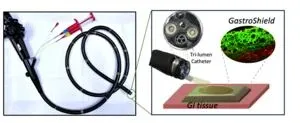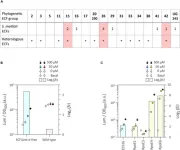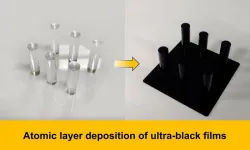(Press-News.org) DURHAM, N.C. -- It might look like a roll of chicken wire, but this tiny cylinder of carbon atoms -- too small to see with the naked eye -- could one day be used for making electronic devices ranging from night vision goggles and motion detectors to more efficient solar cells, thanks to techniques developed by researchers at Duke University.
First discovered in the early 1990s, carbon nanotubes are made from single sheets of carbon atoms rolled up like a straw.
Carbon isn’t exactly a newfangled material. All life on Earth is based on carbon. It’s the same stuff found in diamonds, charcoal, and pencil lead.
What makes carbon nanotubes special are their remarkable properties. These tiny cylinders are stronger than steel, and yet so thin that 50,000 of them would equal the thickness of a human hair.
They’re also amazingly good at conducting electricity and heat, which is why, in the push for faster, smaller, more efficient electronics, carbon nanotubes have long been touted as potential replacements for silicon.
But producing nanotubes with specific properties is a challenge.
Depending on how they’re rolled up, some nanotubes are considered metallic – meaning electrons can flow through them at any energy. The problem is they can’t be switched off. This limits their use in digital electronics, which use electrical signals that are either on or off to store binary states; just like silicon semiconductor transistors switch between 0 and 1 bits to carry out computations.
Duke chemistry professor Michael Therien and his team say they’ve found a way around this.
The approach takes a metallic nanotube, which always lets current through, and transforms it into a semiconducting form that can be switched on and off.
The secret lies in special polymers -- substances whose molecules are hooked together in long chains -- that wind around the nanotube in an orderly spiral, “like wrapping a ribbon around a pencil,” said first author Francesco Mastrocinque, who earned his chemistry Ph.D. in Therien’s lab at Duke.
The effect is reversible, they found. Wrapping the nanotube in a polymer changes its electronic properties from a conductor to a semiconductor. But if the nanotube is unwrapped, it goes back to its original metallic state.
The researchers also showed that by changing the type of polymer that encircles a nanotube, they could engineer new types of semiconducting nanotubes. They can conduct electricity, but only when the right amount of external energy is applied.
“This method provides a subtle new tool,” Therien said. “It allows you to make a semiconductor by design.”
Practical applications of the method are likely far off. “We're a long way from making devices,” Therien said.
Mastrocinque and his co-authors say the work is important because it’s a way to design semiconductors that can conduct electricity when struck by light of certain low-energy wavelengths that are common but invisible to human eyes.
In the future for instance, the Duke team’s work might help others engineer nanotubes that detect heat released as infrared radiation, to reveal people or vehicles hidden in the shadows. When infrared light -- such as that emitted by warm-blooded animals -- strikes one of these nanotube-polymer hybrids, it would generate an electric signal.
Or take solar cells: this technique could be used to make nanotube semiconductors that convert a broader range of wavelengths into electricity, to harness more of the Sun’s energy.
Because of the spiral wrapper on the nanotube surface, these structures could also be ideal materials for new forms of computing and data storage that use the spins of electrons, in addition to their charge, to process and carry information.
The researchers describe their results March 11 in the journal Proceedings of the National Academy of Sciences.
This research was supported by the Air Force Office of Scientific Research (FA9550-18-1-0222), the National Institutes of Health (1R01HL146849), the United States National Science Foundation (CHE-2140249, DGE-2040435) and the John Simon Guggenheim Memorial Foundation.
CITATION: "Band Gap Opening of Metallic Single-Walled Carbon Nanotubes via Noncovalent Symmetry Breaking," Francesco Mastrocinque, George Bullard, James A. Alatis, Joseph A. Albro, Animesh Nayak, Nicholas X. Williams, Amar Kumbhar, Hope Meikle, Zachary X. W. Widel, Yusong Bai, Alexis K. Harvey, Joanna M. Atkin, David H. Waldeck, Aaron D. Franklin and Michael J. Therien. Proceedings of the National Academy of Sciences, March 11, 2024. DOI: 10.1073/pnas.2317078121
END
Spiral wrappers switch nanotubes from conductors to semiconductors and back
Duke researchers are devising new ways to engineer carbon-based semiconductors for electronics of the future
2024-03-12
ELSE PRESS RELEASES FROM THIS DATE:
Researchers identify distinct sleep types and their impact on long-term health
2024-03-12
UNIVERSITY PARK, Pa. — Poor sleep habits are strongly associated with long-term chronic health conditions, according to decades of research. To better understand this relationship, a team led by researchers in Penn State’s College of Health and Human Development identified four distinct patterns that characterize how most people sleep. These patterns are also predictive of long-term health, the researchers said.
Soomi Lee, associate professor of human development and family studies at Penn State, ...
City of Hope to present new research at the American Association of Cancer Research (AACR) Annual Meeting 2024, highlighting promising data on prostate, colorectal and pancreatic cancer
2024-03-12
This year, City of Hope doctors and scientists will also present data during AACR’s Press Program and a clinical trials plenary session:
Monday, April 8, 2024, at 8:30 a.m.
Research by Ajay Goel, Ph.D., M.S., City of Hope professor and chair, Department of Molecular Diagnostics and Experimental Therapeutics, and Caiming Xu, Ph.D., a postdoctoral fellow in Goel’s lab, will be presented at an AACR press conference. The abstract is titled “An exosome-based liquid biopsy for non-invasive, early detection of patients with pancreatic ductal adenocarcinoma: A multicenter ...
Exploring the transferability of extracytoplasmic function switches across bacterial species
2024-03-12
Extracytoplasmic function sigma factors (ECFs) have been successfully used for constructing predictable artificial gene circuits bacteria like Escherichia coli, but their transferability between species within the same phylum remained unknown. Now, a recent study by a group of researchers from Germany and Australia explored the bacteria Sinorhizobium meliloti and identified ECF switches with cross-species functionality, constructed genetic circuits, and provided a toolbox for universal synthetic biology applications.
In the field of synthetic biology, creating artificial gene circuits with predictable outcomes is both a challenge and a necessity. Extracytoplasmic function sigma factors ...
Cannabis use and its multifaceted impact on the genitourinary system: a scoping review of the literature
2024-03-12
Background and objectives
Cannabis is a commonly used recreational and therapeutic substance in our society. There are a variety of established physical, social, and mental health impacts associated with cannabis use. However, there is no overview of the impact cannabis use has on the genitourinary system. Thus, this scoping review aims to present data on the impact of cannabis on the genitourinary system.
Methods
A scoping review search was undertaken on Embase, Medline, and Web of Science. There were no date restrictions ...
SwRI develops off-road autonomous driving tools focused on camera vision
2024-03-12
SAN ANTONIO — March 12, 2024 — Southwest Research Institute has developed off-road autonomous driving tools with a focus on stealth for the military and agility for space and agriculture clients. The vision-based system pairs stereo cameras with novel algorithms, eliminating the need for lidar and active sensors.
“We reflected on the toughest machine vision challenges and then focused on achieving dense, robust modeling for off-road navigation,” said Abe Garza, a research engineer in SwRI’s Intelligent Systems Division.
Through internal research, SwRI engineers developed a suite of tools known as the Vision for Off-road Autonomy (VORA). The passive ...
Patients with obesity and kidney failure may be newly eligible for kidney transplants
2024-03-12
Key Takeaways
A collaborative study between bariatric and transplant teams has created a viable pathway for patients with obesity who also have end-stage renal disease to become eligible for kidney transplants through weight loss surgery.
Postoperative outcomes indicate significant improvements in BMI, hypertension, and diabetes management, enhancing patients’ overall health and transplant viability.
High drop-off rates emphasize the need for enhanced patient ...
Ultrablack coating could make next-gen telescopes even better
2024-03-12
WASHINGTON, March 12, 2024 – Sometimes, seeing clearly requires complete black. For astronomy and precision optics, coating devices in black paint can cut down on stray light, enhancing images and boosting performance. For the most advanced telescopes and optical systems, every little bit matters, so their manufacturers seek out the blackest blacks to coat them.
In the Journal of Vacuum Science & Technology A, by AIP Publishing, researchers from the University of Shanghai for Science and Technology and the Chinese Academy of Sciences developed an ultrablack thin-film coating for aerospace-grade magnesium alloys. Their coating absorbs 99.3% of light while being ...
Adolescent Δ8-THC and marijuana use in the US
2024-03-12
About The Study: The results of a nationally representative 2023 survey indicate that Δ8- tetrahydrocannabinol (THC) use prevalence is appreciable among adolescents and is higher in states without marijuana legalization or existing Δ8-THC regulations. Prioritizing surveillance, policy, and public health efforts addressing adolescent Δ8-THC use may be warranted.
Authors: Adam M. Leventhal, Ph.D., of the University of Southern California in Los Angeles, is the corresponding author.
To access the embargoed study: Visit our For The Media website at this link https://media.jamanetwork.com/
(doi:10.1001/jama.2024.0865)
Editor’s Note: Please see the ...
ADHD pharmacotherapy and mortality in individuals with ADHD
2024-03-12
About The Study: In this observational, target trial emulation analysis that included 148,000 individuals diagnosed with attention-deficit/hyperactivity disorder (ADHD) in Sweden, initial dispensation of ADHD medication was significantly associated with lower all-cause and unnatural-cause mortality, whereas the association with natural-cause mortality was not significant.
Authors: Zheng Chang, Ph.D., and Lin Li, Ph.D., of the Karolinska Institutet in Stockholm, are the corresponding authors.
To ...
Mortality for time-sensitive conditions at urban vs rural hospitals during the pandemic
2024-03-12
About The Study: In this study of 3,813 hospitals, patient outcomes for time-sensitive conditions (acute myocardial infarction, hip fracture, gastrointestinal hemorrhage, pneumonia, sepsis, and stroke) were worse during the COVID-19 pandemic than before, with different magnitudes of change at urban versus rural hospitals. Mobilizing strategies tailored to the different needs of urban and rural hospitals may help reduce the likelihood of excess deaths during future public health crises.
Authors: H. Joanna Jiang, Ph.D., of the Agency ...
LAST 30 PRESS RELEASES:
University of Oklahoma researcher awarded funding to pursue AI-powered material design
Exploring how the visual system recovers following injury
Support for parents with infants at pediatric check-ups leads to better reading and math skills in elementary school
Kids’ behavioral health is a growing share of family health costs
Day & night: Cancer disrupts the brain’s natural rhythm
COVID-19 vaccination significantly reduces risk to pregnant women and baby
The role of vaccination in maternal and perinatal outcomes associated with COVID-19 in pregnancy
Mayo Clinic smartwatch system helps parents shorten and defuse children's severe tantrums early
Behavioral health spending spikes to 40% of all children’s health expenditures, nearly doubling in a decade
Digital cognitive behavioral treatment for generalized anxiety disorder
Expenditures for pediatric behavioral health care over time and estimated family financial burden
Air conditioning in nursing homes and mortality during extreme heat
The Alps to lose a record number of glaciers in the next decade
What makes a good proton conductor?
New science reporting guide published for journalists in Bulgaria
New international study reveals major survival gaps among children with cancer
New science reporting guide published for journalists in Turkey
Scientists develop a smarter mRNA therapy that knows which cells to target
Neuroanatomy-informed brain–machine hybrid intelligence for robust acoustic target detection
Eight SwRI hydrogen projects funded by ENERGYWERX
The Lundquist Institute and its start-up company Vitalex Biosciences Announces Strategic Advancement of Second-Generation fungal Vaccine VXV-01 through Phase 1 Trials under $40 Million Competitive Con
Fine particles in pollution are associated with early signs of autoimmune disease
Review article | Towards a Global Ground-Based Earth Observatory (GGBEO): Leveraging existing systems and networks
Penn and UMich create world’s smallest programmable, autonomous robots
Cleveland researchers launch first major study to address ‘hidden performance killer’ in athletes
To connect across politics, try saying what you oppose
Modulating key interaction prevents virus from entering cells
Project explores barriers to NHS career progression facing international medical graduates
Jeonbuk National University researchers explore the impact of different seasonings on the flavor perception of Doenjang soup
Two Keck Medicine of USC Hospitals named Leapfrog Top Teaching Hospitals
[Press-News.org] Spiral wrappers switch nanotubes from conductors to semiconductors and backDuke researchers are devising new ways to engineer carbon-based semiconductors for electronics of the future




